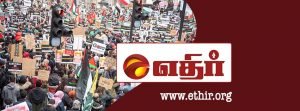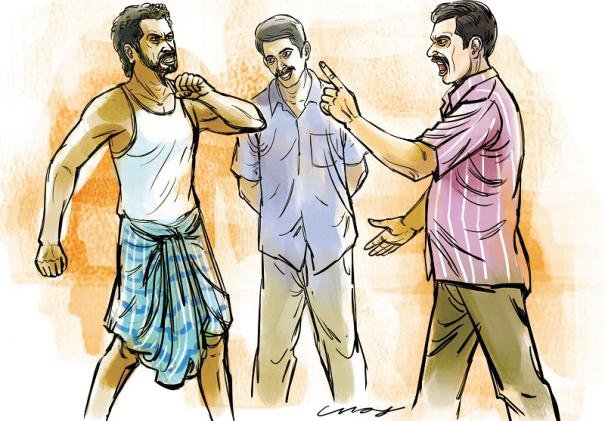Provincial election shows Rajapaksa regime can be challenged
30/09/2013, socialistworld.net
Building a left alternative; link fight against regime with struggle of oppressed Tamils and system change
USP (United Socialist Party – CWI) Reporters

A total of 3,785 candidates contested for a total of 142 seats in three provincial elections which were held in Sri Lanka on 21 September. In addition to the North Western province and Central province, the election was held in the North Province after a 25 year gap. The Rajapaksa regime was forced to hold the election in the north as a compromise before the Commonwealth Heads of Government Meeting (COHGM) is held in Colombo this November.
Many of Rajapaksa’s coalition partners campaigned against holding the election in the north at all. But with much reluctance, and after declaring that powers over the police and land would be withheld, the regime agreed to hold the elections. But all the tactics of the ruling UPFA (United People’s Freedom Alliance) failed. They suffered an historical defeat in the Northern Province at the hands of the TNA (Tamil National Alliance). Basil Rajapaksa, the president’s brother and economic development minister, had spoken in a Western province election meeting on 16th September saying: “A major victory is essential to counter a possible TNA attempt to show the world they have the mandate to divide the country if they win the Northern PC election on a racist separatist agenda”. But they suffered a heavy defeat. In the other two provinces, the UPFA managed to maintain its vote base with an overall percentage of 55.6% (77 seats).
The ruling alliance had pumped millions of rupees and had illegally used government facilities to campaign in the election. Talk about “International conspiracies [being used] to deny the country of its gains from the war victory” and the promise of “development” dominated their campaign. However a strong message of defiance came from the North. The TNA won an historic 78.48% of the votes. The turnout was 68% – another record.
The lack of any alternative, in particular the bankruptcy of the capitalist opposition party, the UNP (United National Party), partly aided the UPFA vote in other provinces. The UNP suffered a major setback; it only managed to win 28 seats in total, obtaining just 21.86% of the total vote.
The government is now boasting of a major victory in the South. But other factors aided their victory. For example, Dayasiri Jayasekara switched from the UNP to the UPFA. He won 84.43% of the Panduwasnuwara electorate – a record-breaking victory for ruling party. The UNP suffered a historicaly worse defeat in this area and most of the votes were taken for the UPFA. Throughout the election campaign the UPFA had UNP defectors on stage in their election rallies. The Dayasiri factor also had an impact in nearby regions.
Violent rivalries
In the Central province, the election was marked by violence between the Ceylon Workers’ Congress (CWC) and the National Workers’ Union (NWU). The rivalry between them resulted in violence and there were also big hand-outs made to poor families in order to win votes. The leaders of both these parties – Arumugam Thondaman and P Digambaram respectively – are part of the UPFA government. Thondaman was a minister in the UPFA government. Digambaram was elected as a UNP member and later defected to UPFA, allegedly in return for various perks. The key victory in this province for the ruling UPFA was secured through them. The CWC won 6 seats under the UPFA banner and 2 independently. The NWC won 3 seats.
The only party to gain from this lack of a clear alternative was the party of the former general, Sarath Fonseka, and the DP (Democratic Party) which won 5 seats. With a 3.39% vote, the DP is now claiming they will be a ’third force’ in the country.
The current state of affairs has consolidated the Sinhala nationalist forces to a large extent which were a key factor behind the victory of the UPFA and DP vote. Though the current regime tried discrediting Fonseka to rob him of the war victory glory, he still enjoys the support of Sinhala nationalist elements to some extent. But his former allies in the JVP, however, are now trying to take off their chauvinist clothes and pretend to be revolutionary. They are beginning to lose their nationalist base and have suffered a humiliating defeat. The JVP only managed to win one seat with just 1.25% of the vote. This is a significant drop as they had 3.5% in the last election.
The major defeat in the North has weakened the current regime in many ways. In the run-up to the election, President Mahinda Rajapaksa and others in the government even admitted that they would not win. However, they hoped to kill two birds with one stone. Firstly, in response to critics who oppose the hosting of the Commonwealth Heads of Government Meeting, Rajapaksa hoped to brag that ‘free and fair’ elections had been held under his watch in the North for the first time since the 1980s. But secondly, he hoped to prove that the government also enjoys significant support among the Tamil people. But both ‘birds’ flew off unharmed!
Defeat for government’s puppet party
The most significant defeat was for the government’s puppet party – the EPDP (Eelam People’s Democratic Party). They maintained an iron grip at gunpoint in the Keytes area for a long time. Even this so-called ‘strong-hold’ revolted. Angered by the defeat, more than 26 TNA supporters were attacked in this area the day after the election result was announced.
Angajan Ramanathan, the ruling party’s Jaffna district organiser, was challenging for the same territory as Douglas Devananda of the EPDP and pushed back votes for their candidates. Many violent incidents, including a shooting incident, took place between these two pro-government groups. One of the main claims of the ruling party – that they had ended the culture of violence – severely backfired.
The result indicates a serious polarisation taking place in the country. The historic turnout in the North, to show defiance and protest against the government, squeezed the votes for other parties. The United Socialist Party (USP ) stood in the election to give a socialist alternative to the masses. It had predicted that the Tamil people would register their protest vote through voting for the TNA. A USP leaflet pointed out that forcing the government to hold this election was itself, in a way, a victory for the Tamil people. The leaflet further pointed out that there should not be any illusions in the Indian state or other imperialist forces. It called for the building of an independent and fighting organisation to advance the fight for the rights of Tamil-speaking people. The just under 200 votes that the USP received is not an accurate representation of the warm reception for the USP leaflet.
In the Nuwara Elliya district the USP received well over 500 votes. This is a significant victory considering the level of corruption and extent of hand-outs during the election. With few resources and great courage, USP members had to fight back against the corrupted goons of the CWC and NWU.
Now the Northern province has become the only province that is governed by an opposition party. Of course, as the USP leaflet explained, the TNA will not be able to take the struggle of the Tamils forward. Already they have given indications that they are ready to comply with the regime. They promised to the masses that investment from the so-called ‘international community’ will take place through them. Their view on the economy is not much different from that of UNP – i.e. for profit-making capitalist ’development’.
Workers and opposition forces should take opportunity to strike against regime
Sri Lanka’s economy is rapidly slowing down. Already this is beginning to have an impact. Bank lending has slowed down and overdraft facilities for small businesses are slowly being stopped. A number of small businesses have been going bankrupt; many have closed down. There have been a number of suicides taking place as a direct consequence of the suffering of small businesses. In the North, an old women who lost her savings and her small tailoring business, threatened to kill herself right outside the Indian Overseas Bank.
Prices of essential commodities are continually on the increase. None of the capitalists’ parties, including the TNA, offered any way out of this widespread misery.
If the economy slows down further, there is no way of escaping the crisis. We will see the devastation of thousands of livelihoods and a further catastrophic decline in living standards. This will only further add fuel to the polarisation between Tamil and Sinhala people, giving rise to further escalations of violent outbursts.
Champika Ranawak, leader of the racist Buddhist monks’ party – the JHU (Jathika Hela Urumaya) – warned that the TNA is “trying to make a Nanthikadal out of Wellawatta”. Nanthikadal is the lagoon where tens of thousands of Tamils were killed during the end of the war in 2009. Wellawetta is the predominantly Tamil area in the capital city, Colombo. While this has angered the Tamils, including the urban Tamil people, the increasingly dictatorial government is leaning on very racist forces such as the JHU for their survival.
The election result shows, however, that this regime can be challenged. Workers and opposition forces should take the opportunity of a weak moment to strike against the Rajapaksa regime and fight in the best traditions of the Sri Lankan working class. Building a left alternative with a clear perspective is vital – one that can link the fight against the regime, and the struggle of the oppressed Tamil masses, to the need to change the capitalist system itself – the ultimate cause of all these problems. This is the mammoth task ahead.
 Post on facebook
Post on facebook
















